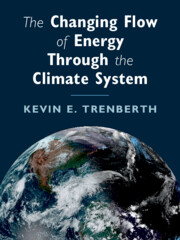Book contents
- The Changing Flow of Energy through the Climate System
- The Changing Flow of Energy through the Climate System
- Copyright page
- Contents
- Foreword
- Preface
- Acknowledgments
- 1 Earth and Climate System
- 2 Earth’s Energy Imbalance and Climate Change
- 3 Earth’s Energy Balance
- 4 The Sun–Earth System
- 5 Observations of Temperature, Moisture, Precipitation, and Radiation
- 6 The Climate System
- Flows of Energy
- 7 The Weather Machine
- 8 The Dynamic Ocean
- 9 Poleward Heat Transports by the Atmosphere and Ocean
- 10 The Changing Hydrological Cycle
- 11 Teleconnections and Patterns of Variability
- 12 El Niño
- 13 Feedbacks and Climate Sensitivity
- 14 Earth’s Energy Imbalance Estimates
- 15 Attribution and the Hiatus
- 16 Prediction and Projection
- 17 Emissions and Information
- 18 Climate Change and Environmental Issues
- Glossary
- Acronyms
- Bibliography
- Index
- References
8 - The Dynamic Ocean
from Flows of Energy
Published online by Cambridge University Press: 25 February 2022
- The Changing Flow of Energy through the Climate System
- The Changing Flow of Energy through the Climate System
- Copyright page
- Contents
- Foreword
- Preface
- Acknowledgments
- 1 Earth and Climate System
- 2 Earth’s Energy Imbalance and Climate Change
- 3 Earth’s Energy Balance
- 4 The Sun–Earth System
- 5 Observations of Temperature, Moisture, Precipitation, and Radiation
- 6 The Climate System
- Flows of Energy
- 7 The Weather Machine
- 8 The Dynamic Ocean
- 9 Poleward Heat Transports by the Atmosphere and Ocean
- 10 The Changing Hydrological Cycle
- 11 Teleconnections and Patterns of Variability
- 12 El Niño
- 13 Feedbacks and Climate Sensitivity
- 14 Earth’s Energy Imbalance Estimates
- 15 Attribution and the Hiatus
- 16 Prediction and Projection
- 17 Emissions and Information
- 18 Climate Change and Environmental Issues
- Glossary
- Acronyms
- Bibliography
- Index
- References
Summary
The oceans are wet, and play a major role in the hydrological cycle. They also have a high heat capacity. Section 6.2 provided the basic character of sea water and ocean structure. Figures 5.2 and 5.3 presented maps and the annual cycle of the mean surface air temperatures, and Fig. 5.4 gave the sea surface temperatures (SSTs). The latter are closely related to water vapor and precipitation in the atmosphere over the oceans. The SSTs are supported by the upper ocean temperatures and especially the mixed layer, which is the part of the ocean in direct contact with the surface through wind effects and heating from both radiation and temperatures in the atmosphere (see Fig. 8.8).
- Type
- Chapter
- Information
- The Changing Flow of Energy Through the Climate System , pp. 104 - 120Publisher: Cambridge University PressPrint publication year: 2022

